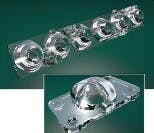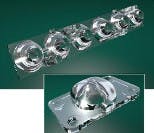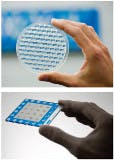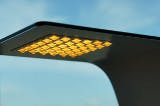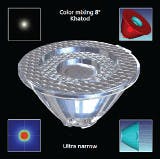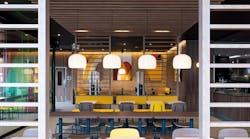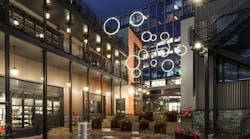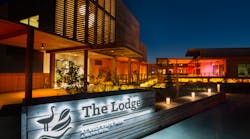+++++
This article was published in the November/December 2013 issue of LEDs Magazine.
Visit the Table of Contents and view the e-zine version in your browser. You can download a PDF of the magazine from within the browser e-zine.
+++++
New and different applications are spawning novel optics for solid-state lighting (SSL) that enable lighting for smaller spaces, manipulate the light and control the beam, and introduce color.
For example, in retail areas, a large reflector can be used for an LED with a large light-emitting surface (LES) or multiple, smaller LEDs can focus on particular areas of a display. Yet today's LED optics are about more than lighting areas: They facilitate intelligent illumination, with streetlighting that reduces light pollution by lighting targeted areas, or even illumination that enhances paintings in galleries or studios with a square light to illuminate a square image, rather than a round one that may produce dark areas.
Bertrand Bercot, optical engineer at Carclo Optics, believes that recent advances in LED technology have created choices. "Until recently, LED was not efficient enough at transforming electricity into light and could not compete with older technologies such as halogen, CFL, and HID," he said. However, this has changed as LED technology offers new advantages. Most lighting companies are now designing their latest products around LEDs and choosing LEDs as the main light source based on energy consumption and a longer product life, which means lower maintenance costs.
This has been driven in the last six years, noted Bercot, by the need for custom design to address specific applications. "We used to design TIR (total internal reflection) optics to support LED manufacturers; now we do a lot of custom design."
Complex lenses
The changes in LED development have resulted in complexity in lenses, moving from TIR to freeform depending on the design, said Bercot. Freeform optics are relatively new. "They allow one lens to perform a complex job, which used to be done by a few lenses — for example, in a streetlight," explained Bercot.
The evolving SSL arena led Carclo to develop diamond turning, or high speed machining, to produce optics that need little polishing. Although the company designs and manufactures both TIR and freeform optics, its most recent designs have been freeform optics and freeform reflectors. Bercot said he sees a general trend of complex or freeform optics being created to meet demanding specifications or particular applications. "Looking at what I have designed in the last two years, it has only been freeform," he said. Freeform lenses are good at controlling the light and at producing a complex beam pattern. "Also," said Bercot, "each application has a niche market."
The resulting freeform optics need little polishing after manufacturing to produce a smooth, clear surface. Recent freeform projects have included streetlights for the European and the North American markets; a high-bay bubble to generate even illumination; a large reflector with freeform facets for large source LEDs; and freeform bubble lighting for road signs and office lighting (Fig. 1). In 2012, the company rebranded its LED team to reflect its specialty in custom optic modules and systems, bespoke, standard optics, reflectors, and holders.
Make it yourself
Equipment for tooling and polishing represents one of the major capital investments for optics companies. The variety of materials used in optical manufacturing can present complications with tool selection; polycarbonates and polycarbonate blends require different treatments. "Challenges exist in production processes and tooling when considering different materials," said Steffan Huber, global head, industrial marketing, Business Unit Polycarbonates at Bayer MaterialScience. "Differences in rheological behavior of different polymers, tooling designs, as well as processing parameters have to be appropriately applied," he advised. There are also polymer molding techniques to consider in optimizing the efficiency of manufacturing. "Furthermore," he pointed out, "depending on the material selected for certain optics, the design of the part would also be different. In more extreme cases, where polymers are compared with metals, significant differences in production, tooling, and design aspects have to be considered."
The fast-moving pace of optics has caused frustration in one professional — then inspiration. Richard van de Vrie decided to take a digital approach to optics. "Each new LED chip is an increase in lumen per watt," he remarked. "It is a constant race to keep up. Lumileds alone introduces around 75 new chips each year; not all of them may be suitable for a particular fixture." Instead of buying new fittings with each LED introduced, he looked for a way to keep pace with the industry and produce custom lighting in high volume.
Initially, 3D printing was considered but dismissed as impractical. Printing layer upon layer of optical material can cause it to lose light quality, van de Vrie explains. Still, he sought to hurdle the obstacles with the company he founded, LUXeXcel, looking to wide-format inkjet printers and adapting them to print optical materials. "Adding hardware and software, with additional tools, meant that they are dedicated, industrial printers that can produce single to thousands of pieces," he told LEDs Magazine.
For each optic design, CAD software creates the design, so the amount of inventory to be held is reduced, as is the investment in injection molding, diamond turning, polishing, or grinding equipment. There is no tooling required for modification or reiteration.
The digital technology also means that there is no minimum order, explains van de Vrie; orders can consist of a single piece to 10,000 pieces, and any modifications in a prototype can be achieved with a CAD file change. There is also a library to which designers can be networked to access CAD files.
Limitless possibilities
Using the wide-format printers, the company produces multifunction optics that have no limit in shape and are full-color lenses (Fig. 2). "We have the ability to create very fluid, yet very high precision optics, with smooth surfaces, "said van de Vrie. The complex freeform designs, with combinations of textures and optics and customization, are not limited to round or oval beam angles.
Moldable, moveable, shapeable optics are created by jetting transparent ultraviolet (UV)-curable polymer droplets on demand and at a resolution of 1440 dpi or more. (The company uses PMMA [polymethyl methacrylate] for the most part but also polycarbonate.) The droplets are cured using UV lamps on the piezoelectric print head; the smooth surface is created in the delay between jetting and application of the UV light. This, claims the company, creates optical-quality surfaces with no post-processing — no polishing or grinding is required.
The droplets can be geometric or freeform, transparent prisms or lenses, producing full-color graphics and textures for LED lighting or graphic displays. "We can print micro-structures, Fresnel lenses, apply special accent spotlights, diffusers… add color, print prism structures and freeform optics. There is no difference," concluded van de Vrie.
Projects can be personalized with colors and texture for architectural aesthetics, but also for lighting effects, said van de Vrie — for example, calculating the optic balance for light in a museum to focus attention or for a streetlight to reduce light pollution (Fig. 3). They can bring all the light where it is wanted — for example, colors for a supermarket display or using filters to create the right red and green for displays of apples. Adding ink to the printing process does not diffuse the light, explained van de Vrie, as there are no layers in the sheets that are produced. Just as in its close relation, color graphics printing, with Printoptical technology color tints can be printed within the optic itself and to high resolution. That color can also be adjusted to meet decorative or application specifications.
The use of color
Color is also a theme at Khatod, although it's approached in a different way. Donatella Pizalis, optical engineer at Khatod, explained the technologies used to add a little Italian flair, with high-efficiency, colored optics. The company has customized coating machinery to produce reflectors that achieve high brightness, with high intensity flux or energy, but which work as a lens to collect light and reflect it into a perfect beam. Most recently, the company added Color Mixing Optics, RGBW color-mixing lenses in 35- and 45-mm diameters, with a full range of beam angles from 8° up to 40°. Color-mixing RGBW of the light from the LED source, from very narrow to wide beam angles, enables architectural, retail, or stage lighting; downlights; flashlights; and border or contour lighting. The optic produces a uniform flux and eliminates shadows or glare, claimed the company. The optical-grade PMMA lens operates within the temperature range from -40 to +90°C and can be stored at the same temperatures.
An accessory, the Moving Lenslet Array (MLA) can be mounted on top of the lens to zoom and autofocus. By sliding the MLA (with the same diameter as the lens), the beam can be varied from 11° to 45°, yet preserve perfect color-mixing and high optical efficiency over 90% through the full range of beam angles, said the company.
For over 30 years, Khatod has been producing optics; it was the first to customize the injection-molding process for PMMA or PVC lenses, said Marina Rossi, marketing manager at Khatod. It also created a cold injection process for silicone lenses, enthused Rossi. Both are important materials for the company. "Silicone operates in higher temperatures than PMMA, and does not require insulation for use outdoors or to withstand humidity," said Pizalis. "On the other hand, PMMA is bright, totally transparent, and resistant to UV rays." For bright indoor areas and for aesthetic reasons, PMMA adds clarity and even glamour. Pizalis summed up its use thus: "If you light a show window at a jeweler's [shop], the lights must shine and appear like jewels, too."
